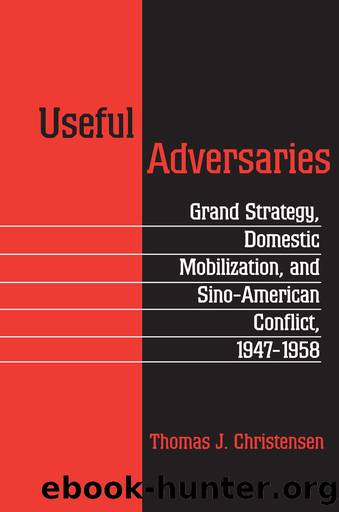Useful Adversaries by Thomas J. Christensen;

Author:Thomas J. Christensen;
Language: eng
Format: epub
Publisher: Princeton University Press
Published: 2020-06-15T00:00:00+00:00
Maoâs Risk Analysis
Contrary to the threat-based accounts discussed above, an October 2 telegram to Stalin found in the Chinese archival collections demonstrates that Mao fully considered the possibility of an American declaration of war and bombardment of âmany major cities and industrial targetsâ in China (see Appendix B). Mao did not discuss atomic weapons, but he clearly envisioned massive conventional strategic bombing.91 Mansourovâs study of Russian documents portrays a CCP even more concerned with the threat of an American declaration of war than the Chinese documents reveal. In the Russian version of Maoâs October 2 message to Stalin, Mao reveals that Central Committee members believed that China should not enter the war in Korea because open warfare with the United States would delay Chinaâs economic development and create popular discontent. Mansourov argues that in the early days of October Stalin failed to convince the CCP that Chinese entrance into Korea was wise. Stalin used two arguments for this purpose: first, he argued that the United States was not ready for a world war, so China need not fear that America would launch a direct attack on a Soviet ally; second, if America was indeed ready for a world war, 1950 was the best time for the communist bloc to fight such a war. In Mansourovâs account, the final decision by Mao and the Central Committee to enter the war was not driven by Stalinâs reassurances but by the fear engendered by American forces crossing the parallel on October 7 and by Stalinâs clever threat to acquiesce fully to American domination of Korea if China did not send in ground troops.92 While the discrepancies between the Russian and Chinese versions of events on October 2 and October 3 remain an interesting puzzle, the Russian account supports strongly the argument that Mao and the CCP Politburo entered the Korean War fully aware of the threat of American retaliation against the Chinese mainland.
Some scholars suggest that Maoâs statements to Stalin about American bombing and declaration of war may have been a ploy to get the Soviets more involved in Korea by triggering the Sino-Soviet defense treaty.93 But other evidence demonstrates that Maoâs stated fears were sincere. Peng Dehuai reports that he and Mao discussed the threat of American bombing with the Chinese Politburo and that Peng had prepared Chinese forces for such an eventuality.94 Beijingâs fear of American bombing never diminished in the first months of U.S. operations. On November 22, two days before MacArthurâs final drive north, the Central Military Commission warned South China forces that American pilots flying under the guise of Chiangâs air force might make bombing runs against Chinese targets.95
Mao had every reason to believe that America would launch such an attack. Declassified American documents show that the State Department plotted a âcalculated indiscretionâ by the American ambassador to India, Loy Henderson, stating that if China attacked in Korea or the Taiwan Straits âthe United States will consider itself at war, and not only deal with such Chinese forces as may be met in the field but also strike at the bases of Chinese power.
Download
This site does not store any files on its server. We only index and link to content provided by other sites. Please contact the content providers to delete copyright contents if any and email us, we'll remove relevant links or contents immediately.
Chaco's Northern Prodigies : Salmon, Aztec, and the Ascendancy of the Middle San Juan Region after AD 1100 by Paul F. Reed(338)
Law Enforcement Interpersonal Communication and Conflict Management by Brian Douglas Fitch(331)
Digital International Relations by Unknown(324)
Critical Perspectives on Human Security : Rethinking Emancipation and Power in International Relations by David Chandler; Nik Hynek(315)
The Enduring Color Line in U.S. Athletics by Krystal Beamon Chris M. Messer(309)
Skilled interpersonal communication: Research, theory and practice, Fifth edition by Owen Hargie(309)
Evidence-Based Policy Making in Labor Economics by Hamermesh Daniel S.;Nottmeyer Olga K.;Nottmeyer Olga;King Sarah;King Sarah;King Sarah;(277)
EPSO CAST Political affairs EU policies: How to succeed in the selection procedure by Franco Reverte José María(272)
Writing Public Policy - A Practical Guide to Communicating in the Policy Making Process by Catherine F. Smith(256)
Threshold Concepts in Women's and Gender Studies by Christie Launius Holly Hassel(249)
Criminological Theory in Context by John Martyn Chamberlain(249)
Positive Psychology and Spirituality in Counselling and Psychotherapy (Conflict, Ethics, and Spirituality, 12) by unknow(245)
Tibeton Yoga Its Secret Doc by Evans-Wentz(244)
Social Problems, Social Issues, Social Science by James Wright(243)
Rothschild and Early Jewish Colonization in Palestine (Geographical Perspectives on the Human Past) by Ran Aaronsohn(243)
Play in child development and psychotherapy: toward empirically supported practice by Sandra W. Russ(239)
Cognitive Development in Infancy and Childhood (Elements in Child Development) by Mary Gauvain(235)
Latin American Politics and Society by Gerardo L. Munck & Juan Pablo Luna(208)
What Makes a Social Crisis?: The Societalization of Social Problems by Jeffrey C. Alexander(206)
